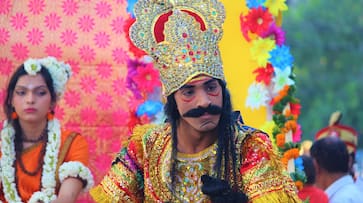Ramlila, a vibrant theatrical performance of the Ramayana, transcends cultural boundaries, captivating audiences with its dramatic storytelling and profound symbolism. Celebrated during Navratri, particularly Dussehra, Ramlila's enduring legacy is a testament to its ability to unite communities and preserve cultural heritage.
As the Navratri season begins in October, vibrant celebrations and cultural festivities come to life, including the enchanting Ramlila performances that are held across the country. These elaborate reenactments of the epic Ramayana not only captivate audiences with their dramatic storytelling and colourful costumes but also serve as a profound expression of devotion and community spirit.
The tradition of Ramlila dates back centuries. It is a traditional Indian theatrical performance that dramatizes the life and adventures of Lord Rama, as narrated in the epic Ramayana. Ramlila combines elements of music, dance, and dialogue to convey the themes of good versus evil. Performers don vibrant costumes and enact various scenes, culminating in the triumph of Rama over Ravana. Have you ever wondered how these performances have evolved and the significance they hold in contemporary society?
Recognition
In 2008, UNESCO recognised Ramlila as one of the "Intangible Cultural Heritage of Humanity," highlighting its cultural significance and the rich traditions associated with it. This vibrant celebration is especially important in historically rich Hindu cities such as Ayodhya, Varanasi, Vrindavan, Almora, Satna, and Madhubani, which are located in Uttar Pradesh, Uttarakhand, Bihar, and Madhya Pradesh. Each of these cities contributes its own unique flavour to the performances, showcasing local customs, artistry, and community involvement.
Going back in history
In Indonesia, particularly within the Hindu community of Bali, Ramlila has integrated into local traditions, enriching the cultural landscape. Similarly, the narrative has found its way into the artistic practices of Myanmar, Cambodia, and Thailand, where it continues to resonate with audiences.
According to historians, in the 19th and 20th centuries, the Indian diaspora, who migrated as indentured labourers to European colonies, played a crucial role in the global dissemination of Ramlila. As these communities settled in various parts of the world, they brought with them their cultural celebrations, including Ramlila. This expansion has led to vibrant performances being held in countries such as Mauritius, Africa, Fiji, Guyana, Malaysia, Singapore, South Africa, Suriname, and Trinidad and Tobago.
Today, Ramlila is celebrated far beyond its origins, with communities in the United States, Canada, the United Kingdom, the Netherlands, Australia, and New Zealand participating in this age-old tradition. The flexibility of Ramlila shows how important it still is today. It brings people together from different cultures and generations, highlighting the values of good triumphing over evil and the significance of community.
More on Ramayana
Ramlila is one of the many performance arts celebrated within Hinduism, showcasing the rich tapestry of cultural expression associated with the faith. The epic Ramayana, which dates back to the 1st millennium BCE, is one of the oldest works in the Itihasa genre of Indian literature. Despite its ancient origins, the exact timeline for the first performances of Ramlila remains unclear, shrouded in tradition and historical ambiguity.
According to South Asian Folklore: An Encyclopedia (published by Routledge), the first documented enactment of the Ramcharitmanas, composed by the revered poet Tulsidas in the 16th century, is not specifically recorded. According to tradition, Megha Bhagat, a disciple of Tulsidas, began the Ramcharitmanas-based Ramlila in 1625. This act not only popularised the performance but also established a cultural framework for future generations.
Norvin Hein, an expert in Indology, in his works like 'The Miracle Plays of Mathura' and 'The Ram Lila' notes that Ramlila had gained popularity in North India well before 1625. He highlights that performances inspired by Valmiki's Ramayana are believed to have originated between 1200 and 1500 CE. This indicates that the roots of Ramlila may extend deeper into the history of Indian theatre than previously thought.
Furthermore, Richard Schechner, a theater director and performance theorist, in his work 'Performative circumstances, from the avant garde to Ramlila' argues that contemporary Ramlila draws from a diverse heritage, merging the teachings of ancient Sanskrit texts with modern theatrical techniques. This blending of the traditional and contemporary not only enriches the performances but also allows Ramlila to resonate with audiences today. As a result, Ramlila continues to thrive as a dynamic art form that bridges the gap between past and present, engaging communities in profound ways.
The traditions
Ramlila festivals are vibrant celebrations that bring the epic story of Lord Rama to life, organised in numerous villages, towns, and neighbourhoods during the autumn Navaratri festival season, which typically occurs in September or October. These festivals serve as both religious and cultural events, fostering a sense of community among participants. As UNESCO highlights, Ramlila brings people together "without distinction of caste, religion, or age," making it a truly inclusive celebration.
The involvement of the audience is a hallmark of Ramlila. People often participate spontaneously, taking on roles in the performance or assisting in various ways, such as setting up and cleaning the stage, creating costumes, and maintaining the Ramlila area. This active engagement not only enhances the festive atmosphere but also strengthens community bonds, allowing everyone to feel a part of the age-old narrative that celebrates the triumph of good over evil. Through these collaborative efforts, Ramlila becomes a shared cultural experience, deeply rooted in tradition yet alive with communal spirit.
Last Updated Oct 3, 2024, 11:03 AM IST









![Salman Khan sets stage on fire for Anant Ambani, Radhika Merchant pre-wedding festivities [WATCH] ATG](https://static-gi.asianetnews.com/images/01hr1hh8y86gvb4kbqgnyhc0w0/whatsapp-image-2024-03-03-at-12-24-37-pm_100x60xt.jpg)
![Pregnant Deepika Padukone dances with Ranveer Singh at Anant Ambani, Radhika Merchant pre-wedding bash [WATCH] ATG](https://static-gi.asianetnews.com/images/01hr1ffyd3nzqzgm6ba0k87vr8/whatsapp-image-2024-03-03-at-11-45-35-am_100x60xt.jpg)


